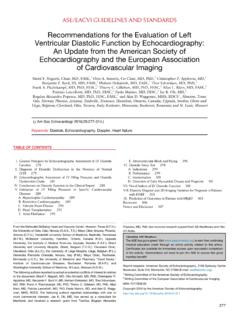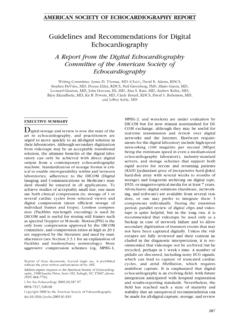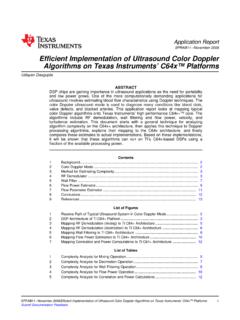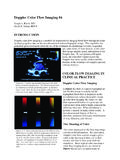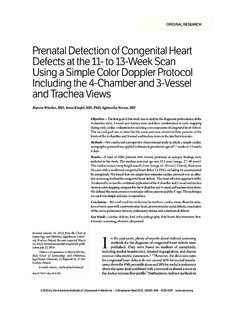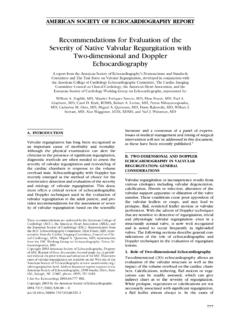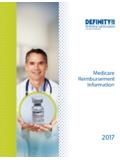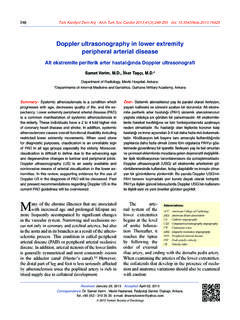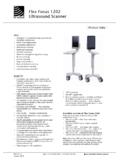Transcription of Recommendations for Evaluation of Prosthetic Valves With ...
1 GUIDELINES AND STANDARDSR ecommendations for Evaluation of Prosthetic ValvesWith Echocardiography and doppler UltrasoundA Report From the American Society of Echocardiography s Guidelines and StandardsCommittee and the Task Force on Prosthetic Valves , Developed in Conjunction With theAmerican College of Cardiology Cardiovascular Imaging Committee, Cardiac ImagingCommittee of the American Heart Association, the European Association ofEchocardiography, a registered branch of the European Society of Cardiology, theJapanese Society of Echocardiography and the Canadian Society of Echocardiography,Endorsed by the American College of Cardiology Foundation, American Heart Association,European Association of Echocardiography, a registered branch of the European Society ofCardiology, the Japanese Society of Echocardiography, and Canadian Society ofEchocardiographyWilliam A. Zoghbi, MD, FASE, Chair, John B. Chambers, MD,*Jean G.
2 Dumesnil, MD, Elyse Foster, MD, John S. Gottdiener, MD, FASE, Paul A. Grayburn, MD, Bijoy K. Khandheria, MBBS, FASE,Robert A. Levine, MD, Gerald Ross Marx, MD, FASE, Fletcher A. Miller, Jr., MD, FASE, Satoshi Nakatani, MD,PhD, Miguel A. Quin ones, MD, Harry Rakowski, MD, FASE, L. Leonardo Rodriguez, MD,Madhav Swaminathan, MD, FASE, Alan D. Waggoner, MHS, RDCS, Neil J. Weissman, MD, FASE,kand Miguel Zabalgoitia, MD,Houston and Dallas, Texas; London, United Kingdom; Quebec City, Quebec, Canada;San Francisco, California; Baltimore, Maryland; Scottsdale, Arizona; Boston, Massachusetts; Rochester, Minnesota;Suita, Japan; Toronto, Ontario, Canada; Cleveland, Ohio; Durham, North Carolina; St Louis, Missouri;Washington, DC; Springfield, IllinoisAccreditation Statement:The American Society of Echocardiography is accredited by the Accreditation Council for Continu-ing Medical Education to provide continuing medical education for ASE designates this educational activity for a maximum of1 AMAPRAC ategory1 Credit.
3 Phy-sicians should only claim credit commensurate with the extent of their participation in the American Registry of Diagnostic Medical Sonographers and Cardiovascular Credentialing In-ternational recognize the ASE s certificates and have agreed to honor the credit hours toward theirregistry requirements for ASE is committed to ensuring that its educational mission and all sponsored educational pro-grams are not influenced by the special interests of any corporation or individual, and its mandate isto retain only those authors whose financial interests can be effectively resolved to maintain thegoals and educational integrity of the activity. Although a monetary or professional affiliationwith a corporation does not necessarily influence an author s presentation, the essential areasand policies of the ACCME require that any relationships that could possibly conflict with theeducational value of an activity be resolved prior to publication and disclosed to the audience.
4 Dis-closures of faculty and commercial support relationships, if any, have been Audience:This activity is designed for all cardiovascular physicians and cardiac sonographers with a primaryinterest and knowledge base in the field of echocardiography. In addition, residents, researchers, cli-nicians, intensivists, and other medical professionals with specific interest in cardiac ultrasound willfind this activity :Upon completing this article, participants will be better able to:1. Name the components of a complete imaging and doppler Evaluation for Prosthetic valve Identify the components of an integrative approach to assessing Prosthetic aortic and mitral valvestenosis and Identify the components of an integrative approach to assessing Prosthetic pulmonary and tricus-pid valve stenosis and Describe the pitfalls and limitations of the Evaluation of Prosthetic valve Recognize the special aspects of the pediatric population that add complexity to the evaluationof Prosthetic valve the Methodist DeBakey Heart and Vascular Center, Houston, Texas ( , ); St Thomas Hospital, London, United Kingdom ( ); Hospital Laval,Quebec City, Quebec, Canada ( ); the University of California, SanFrancisco, San Francisco, California ( ); the University of Maryland Hospital,Baltimore, Maryland ( ); Baylor University Medical Center, Dallas, Texas( ).
5 Mayo Clinic, Scottsdale, Arizona ( ); Massachusetts GeneralHospital, Boston, Massachusetts ( ); Harvard School of Medicine/BostonChildren s Hospital, Boston, Massachusetts ( ); the Mayo Clinic,Rochester, Minnesota ( ); Osaka University Graduate School of Medicine,Suita, Japan ( ); Toronto General Hospital, Toronto, Ontario, Canada ( );the Cleveland Clinic, Cleveland, Ohio ( ); Duke University Medical Center,Durham, North Carolina ( ); Washington University School of Medicine, StLouis, Missouri ( ); Washington Hospital Center, Washington, DC ( );and Prairie Cardiovascular Consultants, Springfield, Illinois ( ).Reprint requests: American Society of Echocardiography, 2100 Gateway CentreBoulevard, Suite 310, Morrisville, NC 27560 Representing the European Association of Echocardiography. Representing theCanadian Society of Echocardiography. Representing the Cardiac ImagingCommittee of the American Heart Association.
6 Representing the JapaneseSociety of the American College of CardiologyCardiovascular Imaging $ 2009 by the American Society of OF CONTENTSI. Introduction 976II. General Considerations With Prosthetic Valves 977A. Types of Prosthetic Valves 977B. Evaluation of Prosthetic Valves With Echocardiography and doppler :General Recommendations 9771. Clinical Data 9782. Echocardiographic Imaging 9783. doppler Echocardiography 979a. Determination of Gradients Across Prosthetic Valves 979b. EOA 980c. Pressure Recovery: Hemodynamic Conditions and ClinicalImplications 980d. PPM 981e. doppler Recordings and Measurements Based on ProstheticValve Position 981f. Physiologic Regurgitation 982g. Pathologic Prosthetic Regurgitation 982C. Considerations for Intraoperative Patients 982D. Complications of Prosthetic Valves 9831. General Considerations: Early Versus Late Complications 983a.
7 Early Complications 983b. Late Complications 9832. Endocarditis 9833. Prosthetic Valve Thrombosis Versus Pannus 984E. Stress Echocardiography in Evaluating Prosthetic Valve Function 9841. Prosthetic Aortic Valves 9842. Prosthetic Mitral Valves 985F. Other Techniques for Assessing Replacement Heart Valves 9861. Cinefluoroscopy 9862. CT 9863. Cardiac Catheterization 986G. Postoperative Evaluation and Follow-Up Studies 986 III. Evaluation of Prosthetic Aortic Valves 986A. Prosthetic Aortic Valve Function and Stenosis 9861. Imaging Considerations 9862. doppler Parameters of Prosthetic Aortic Valve Function 986a. Velocity and Gradients 986b. EOA 987c. DVI 9873. Diagnosis of Prosthetic Aortic Valve Stenosis 987B. Prosthetic Aortic Valve Regurgitation 9891. Imaging Considerations 9892. doppler Evaluation of Severity of Prosthetic AR 989a. Color doppler 989b.
8 Spectral doppler 9903. Role of TEE in Prosthetic AR 9914. An Integrative Approach in Evaluating Prosthetic AR 991IV. Evaluation of Prosthetic Mitral Valves 991A. Prosthetic Mitral Valve Function and Stenosis 9911. Imaging Considerations 991a. Parasternal Views 991b. Apical Views 9922. doppler Parameters of Prosthetic Mitral Valve Function 992a. Peak Early Mitral Velocity 992b. Mean Gradient 993c. Pressure Half-Time 993d. EOA 994e. DVI 9953. Diagnosis of Prosthetic Mitral Valve Stenosis 995B. Prosthetic Mitral Valve Regurgitation 9961. Imaging Considerations 9962. Role of TEE 9963. Assessment of Severity of Prosthetic MR 996V. Evaluation of Prosthetic Pulmonary Valves 996A. Prosthetic Pulmonary Valve Function 9961. Imaging Considerations 9962. Evaluation of Pulmonary Valve Function 998B. Prosthetic Pulmonary Valve Regurgitation 998VI.
9 Evaluation of Prosthetic Tricuspid Valves 998A. Prosthetic Tricuspid Valve Function 9981. Imaging Considerations 9982. doppler Parameters of Tricuspid Prosthetic Valve Function 9993. Diagnosis of Prosthetic Tricuspid Valve Stenosis 999B. Prosthetic TR 10001. Imaging Considerations 10002. doppler Parameters of Tricuspid Prosthetic Valve Regurgita-tion 10003. TEE for Prosthetic Tricuspid Valves 1001 VII. Echocardiographic Evaluation of Prosthetic Valves in the Pediatric Popu-lation 1002A. Prosthetic Valves Are Uncommon in Pediatrics 1002B. Aspects of Pediatric Congenital Heart Disease Alter the StandardApproach to Echocardiographic Prosthetic Valve Evaluation 1002C. Importance of PPM in Pediatrics 1003D. Potential Pitfalls in the Measurement of Prosthetic Valve EOA inPediatrics 1004E. Evaluation of Corresponding Atrial and Ventricular Size andFunction 1004F.
10 The Need for More Research in the Pediatric Population 1004 VIII. Conclusions and Future Directions 1004 Appendix A: Normal doppler Echocardiographic Values forProsthetic Aortic Valves 1010 Appendix B: Normal doppler Echocardiographic Values forProsthetic Mitral Valves1013I. INTRODUCTIONIn patients with significant valvular stenosis or regurgitation, an inter-vention on the valve with repair, valvuloplasty, or valve replacementis ultimately inevitable. Although valve repair is now frequently per-formed, especially for mitral regurgitation (MR) and tricuspid regurgi-tation (TR), valve replacement remains common, particularly inadults. This enlarging cohort may be difficult to assess. Symptomsmay be nonspecific, making it difficult to differentiate the effects ofprosthetic valve dysfunction from ventricular dysfunction, pulmonaryhypertension, the pathology of the remaining native Valves , or noncar-diac conditions.



